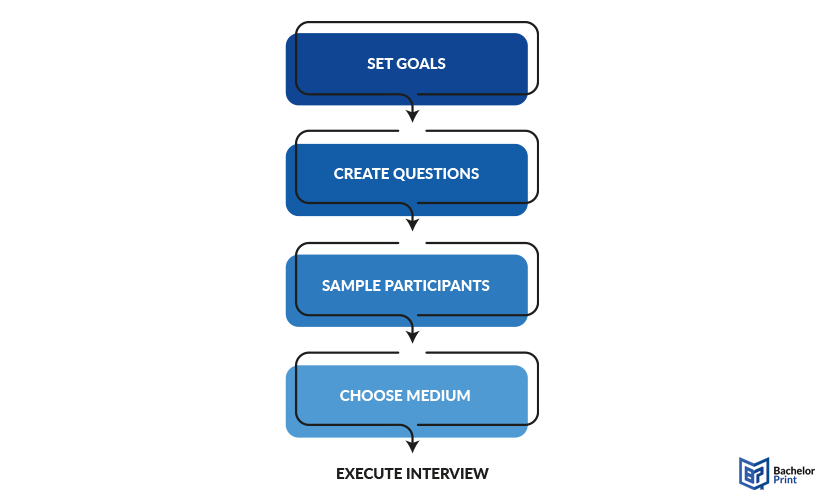
Structured interviews provide equality and validity in their results, while unstructured interviews dive deeper into the individual perspectives and emotions of the interviewee. Sometimes, in research, it can be necessary to apply both methods to get the required results. The methodology of a semi-structured interview might be a good compromise to use then. The following article will cover all relevant information about semi-structured interviews and how to conduct one.
Definition: Semi-structured interview
A semi-structured interview is based on some predetermined questions. However, in contrast to a structured interview, the interviewer is allowed to change their order, skip questions or add new ones if he feels the need to. This is why the semi-structured interview is the perfect combination of the structured and unstructured one.
5-step guide to conducting a semi-structured interview
You can proceed to the subsequent phases if you’ve decided that a semi-structured interview suits your research topic.
Step 1 – Set goals
First, you need to set your research goals. What is the main topic of your interview? What do you want to accomplish? It is important to keep your main themes in mind, so you will not drift off during the interview.
Step 2 – Create questions
Next you have to create the fixed set of questions for your semi-structured interview. Even though you are relatively free in asking questions, your fixed ones should always stay focused on the relevant topics. Furthermore, it is important to think about possible follow-up questions beforehand to keep a steady flow in the conversation later. Depending on how sensitive your topic is, you should also take your choice of words into consideration to not make your participants uncomfortable.
Step 3 – Sample participants
There are three different approaches for sampling participants for your interview.
- One option is to look for random/voluntary samples with flyers or an announcement online. This is a great way to get a variety of different people from different parts of society.
- Another way is stratifying samples. With this method, you choose a specific group of people you want to interview. This can be sorted by age, social status, financial background, etc.
- Probably the easiest way to get participants is through convenience sampling, where you ask your fellow students, family, or friends to take part in your semi-structured interview.
When sampling participants, you should always be wary of sampling bias. That means, you instinctively select similar people for your interview because they, for example, seem the most approachable.
Step 4 – Choose medium
To understand the advantages and disadvantages of using the different data collection methods, you can look at the comparison shown in the table below.
| Pro | Con | |
| On the phone | Participants may talk more open when they do not see the interviewer. | You cannot see your participant's expressions and behaviour. |
| Videochat | Participants are at home, in their comfortable environment. | If the connection to the internet is weak, you might miss important information. |
| In person | You can see their expressions and body language. | High risk of the interviewer effect. |
The interviewer effect describes a phenomenon, when participants feel the need to answer a question the way they think the interviewer would want them to. This leads to untruthful answers and can warp the results of the study.
When you need to record the interview for later transcriptions, always make sure to get written consent from your participants beforehand.
Step 5 – Execute interview
When conducting your semi-structured interview, try to maintain as much environmental consistency as possible throughout the process to eliminate prejudice. You should also consider your body language, your tone of speech or possible disturbing background noises.
Similarly, among the most challenging aspects of semi-structured interviews is to maintain the objectivity of your questions. This can be especially difficult if you ask your participants spontaneous questions or follow-ups that are not scripted.

Pros and cons of a semi-structured interview
Semi-structured interviews are a seemingly perfect combination of the structured and unstructured version. However, as there are many advantages, there are also disadvantages to this form of interview.
The benefits of an unstructured interview are:
-
- Flexibility. A semi-structured interview combines the advantages of both structured and unstructured interviews. Thus, it keeps its validity due to the set questions, but also allows flexibility due to unscripted follow-up questions.
- Natural setting. The semi-structured interview is the one that feels most natural for the respondent. They get clearly defined questions to answer, but can also elaborate further if they feel the need to. This also keeps the flow of the conversation going, as the interviewer can always rely on the predetermined questions in case of a pause.
- No distractions. The predetermined conceptual framework of the semi-structured interview helps to keep the conversation on the topic and avoid getting distracted. On the other hand, it is still open enough to foster a two-way dialogue.
- Rich and detailed data. Due to its nature, the semi-structured interview provides the most valuable data. It keeps validity through the predetermined questions but also leaves room for further elaboration, rephrasing or clarification through open-ended questions.
The disadvantages of an unstructured interview are:
-
- High risk of bias. Similar to the unstructured interview, the semi-structured interview too is likely to end up from a subjective perspective of the interviewer. This is due to the open-ended nature of some questions, which can quickly turn into leading ones, tempting the participant to answer what is expected of them, leading to socially desired bias.
- Less validity. As the semi-structured interview also includes non-fixed questions, it can be challenging to compare the answers of the participants to one another, depending on how much the conversation went into more detailed elaborations.
- Difficult question development. Since you do not know beforehand how the conversation will play out, it might be difficult to create the setup of questions. Especially since every person’s willingness to share is different, the number and detail in the questions can vary drastically, leading to an even harder comparability. Moreover, a more personal approach can also lead to a loss of impartiality.
Formulating the questions
Due to their frequently open-ended nature, it cannot be easy to construct semi-structured interview questions that elicit the desired information without biasing the responses. Listed below are some important points.
- Before the interview, specify the regions or subjects you will focus on. This will assist you in building a framework of information-specific queries.
- Make a list of questions you want to ask yourself before the interview so you don’t get distracted. In the beginning, stick to simple questions and work your way up to more complex ones once you’ve established a rapport with the person.
- Avoid jargon and complex language, and strive for clarity and concision.
Analyzing your semi-structured interview
After completing your interviews, you must assess your findings. For organizational purposes, assign each participant a number or a pseudonym.
Transcription
Choose between verbatim transcription and intelligent verbatim transcription before you begin transcribing interviews. This can either include the behaviour of the participant or exclude it and focus on the facts solely.
- If pauses, laughs, or filler words such as “umm” or “like” impact your study and conclusions, you should conduct verbatim transcription and incorporate them.
- You can do intelligent verbatim transcription, which eliminates fillers, corrects grammatical errors, and is typically simpler to evaluate.
Thematic analysis
The subsequent step is to undertake a theme or content analysis. Typically, this entails “coding” words, patterns, or repeated answers and splitting them into labels or groups for a more comprehensive analysis.
Because semi-structured interviews are more open-ended, a thematic analysis is more likely than content analysis. This is the case due to the individual perspectives you might get from your interviewees.
- Scrutinize your data to uncover common themes, concepts, or patterns. Preliminary conclusions regarding your participants’ perspectives, knowledge, and experiences can be drawn in this way.
- After reviewing your responses, you can collect the data into categories based on their “code.” These codes provide a concise summary of the key data points and trends that have been identified.
- Next, these codes must be organised into themes. Generally, themes are more significant than codes, and several codes are frequently grouped under a single theme. After establishing your themes, ensure they accurately represent the replies’ patterns.
Results
After you’ve analysed your data, you’ll need to write up your results in a research paper.
- Methodology: Your methodology section shows how you obtained the data in this instance, outlining your semi-structured interview procedure, and justifies or conceptualizes your analysis.
- Discussion and results: Typically, your classified categories are addressed in the discussion and result sections, stating merely the facts and findings.
- Conclusions: You might then end by highlighting the essential findings and potential possibilities for future research. This also includes comparing your findings to your hypothesis or leading question of the interview.
Different types of interviews
Before planning and conducting an interview, it is important to find the right form that suits your needs. The table below highlights the similarities and differences between a semi-structured interview, a structured interview, and an unstructured interview.
| Structured interview | Semi-structured interview | Unstructured Interview | |
| Fixed questions | ✔ | ✔ | ✔ |
| Fixed order of questions | ✔ | ✘ | ✘ |
| Fixed number of questions | ✔ | ✘ | ✘ |
| Option to ask additional questions | ✘ | ✔ | ✔ |
FAQs
Semi-structured interviews are the perfect mix of the predetermined set of questions you find in a structured interview, that provides equality and validity. At the same time, it also includes the characteristics of an unstructured interview, namely being able to add spontaneous questions or have the interviewee elaborate further on their statements.
The interviewer effect is the tendency of the participant to give answers, they think would please the interviewer. This, however, can warp the results of the interview and thus invalidate the study. Most often, the interviewer effect appears when the interview is conducted face to face, for the literal closeness of the two people can have a strong effect on the participants.
A semi-structured interview combines the other two forms. While a structured interview has a set number of fixed questions in a particular order, which ensures validity and equality among the participants. An unstructured interview, on the other hand, has no predetermined questions and the interviewer has to make them up along the talk, which leads to more in-depth answers and personal perspectives. The semi-structured interview combines these two, as it has some previously set questions, which can be changed in order or even removed completely, while it also allows spontaneously asked ones or individual follow-ups.
